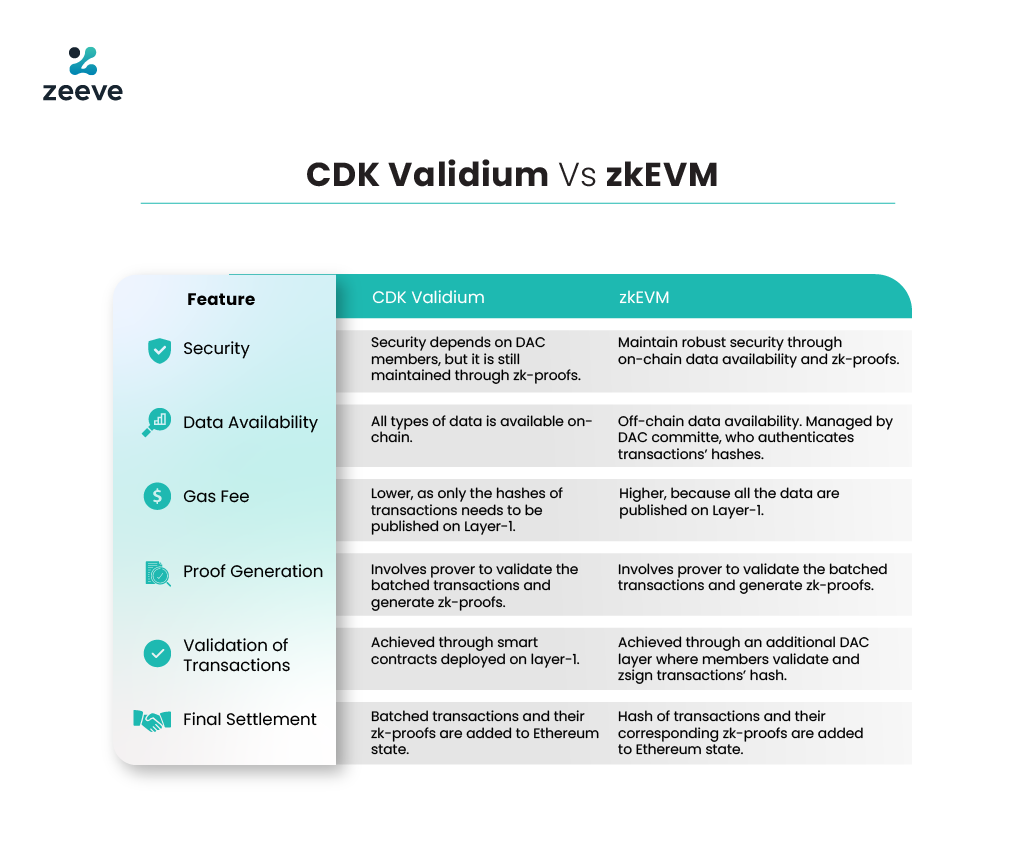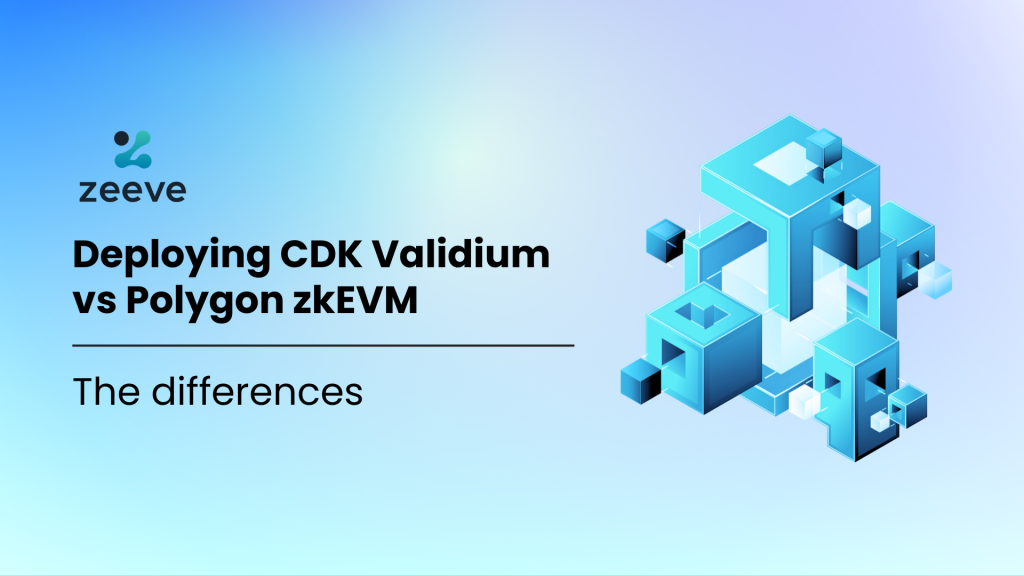CDK validium is currently the most interesting and highly feasible upgrade on the Polygon ecosystem. Validium is designed to enhance the existing scalability, security, and privacy capabilities of Polygon CDK. However, as a new concept, there’s a lot of skepticism among web3 developers and enterprises related to the features, benefits, and use cases of CDK validium. That’s why we see a lack of clarity between CDK Validium and Polygon zkEVM. This guide will explain all the differences of CDK Validium vs Polygon zkEVM deployment, allowing anyone to understand the benefits, deployment approach, requirements, and other parameters for choosing one of these solutions.
What is Polygon CDK Validium?
CDK validium is a solution that performs transaction execution and maintain data availability off-chain. Which means, validiums doesnot store data on underlying Layer-1 chain. Instead, a DA layer with its DAC committee validates the transactions and generate hash that is stored on L1 network. Hence, validium maintains data availability outside of the Ethereum network by implementing a trusted sequencer, referred to as DAC or data availability committee. With that, CDK validium offers benefits like lower transaction fees and state privacy and data integrity. Projects building their CDK chain can adopt ‘validium’ mode for implementing a centralized sequencer, which enhances the throughput, speed, and security on the L1 chain.
What is Polygon zkEVM?
Polygon ZkEVM is a zero-knowledge-based rollup scaling solution that is fully EVM-equivalent, and it involves an off-chain transaction processing approach to increase the throughput and speed of Layer-1. Unlike CDK validium, Polygon zkEVM includes the data availability and execution verification in Layer-1 blockchain itself. Further, it uses Layer-2 rollup network to compute and validate the transactions. Once verified, the validity proofs are submitted on layer-1. Polygon zkEVM is basically a zk-powered public chain that allows dApps and other web3 projects to build on zkEVM’s highly scalable, secure, and low-cost ecosystem or seamlessly migrate from any Layer-1 network, let’s say Ethereum.
CDK Validium vs Polygon zkEVM – Analyzing all the deployment differences
For those who are deploying their projects on Polygon zkEVM or building their CDK chain, this section provides details on CDK validum vs Polygon zkEVM deployment. You can choose an approach based on your specific needs:
1- Comparing Hardware/software requirements
Following deploying a Polygon CDK validium:
- Linux operating system
- A minimum of 16GB RAM with 4-core CPU
- Virtual machine and Hypervisor.
- AMD64 architecture system
- Docker.
- Docker compose.
- Web3 wallet. E.g Metamask
- Access to native LXLY Bridge
For deploying on Polygon zkEVM network:
- A Hypervisor
- A Virtual Machine
- Latest version of Ubuntu Linux.
- Docker.
- 96-core CPU
- Minimum 768GB RAM
- Web3 wallet.
- Access to Polygon zkEVM bridge.
2- Core components required for deployment
CDK Validium:
zkEVM node with Validum extension- As we know, CDK validium is powered by the Polygon zkEVM network. Hence, validium deployment requires a zkEVM node, which is further extended to support Validium-related operations, i.e. the data availability layer.
Data availability layer- This DA layer is a very crucial component of CDK validium, which is responsible for separating the transaction execution from the data storage mechanism so that the load on the mainchain is reduced significantly and privacy is preserved. To do this, the DA layer stores all the transaction data off-chain but publishes their verified hashes on the mainchain. All the operations on the DA layer are managed by DACs (Data Availability Committees) that are tasked to verify off-chain data and ensure their reliability and accessibility.
Validium-specific contract- CDK validium deployment requires a zkEVM smart contract plus a validium-specific DAC contract for enabling validum mode in your desired CDK chain and thereby implementing a dedicated layer for off-chain data storage, execution, and authentication.
Infrastructure- CDK validium needs a dedicated infrastructure that can manage all the rollup-specific elements (prover, aggregator, etc), plus manage the data availability layer and data availability committee (DACs).
Bridge- CDK validiums are independent Zk-powered rollup chains that need to maintain interoperability across them. By implementing a LXLY or any CDK-compatible bridge, this interoperability can be achieved easily.
Rollup-specific components: Sequencer, Synchronizer, Aggregator, and prover.
Other crucial components: JSON RPC, Pool DB, Etherma, and State DB.
zkEVM (rollup):
zkEVM node– The zkEVM node manages the whole Polygon zkEVM network, including execution of transactions, maintaining the network’s state, and enabling interaction with the Layer-1.
zkEVM contracts– The zkEVM smart contract allows zkEVM operations on Layer-1. For example, it allow seamless deployment of Ethereum smart contract on Polygon zkEVM network, allow projects to upgrade their contract code, instead of rewriting or creating the contract from scratch.
Infrastructure- Polygon zkEVM requires a standard Zk-rollup infrastructure to manage nodes, EVM, smart contracts, and rollup-specific elements such as prover, aggregator, sequencer, and synchronizer.
Bridge- Implementation of Polygon bridge or any Ethereum-compatible is crucial to enable bridging of assets from underlying Layer-1 blockchain to rollup network and conversely.
Validum-specific components- Synchronizer, Aggregator, Prover, and on-chain committees.
Other important components– JSON RPC, Pool DB, Sequencer, Etherman,PostgreSQL database, and State DB.
3- Transaction Data flow differences
CDK Validium:
As discussed, data flow in CDK validium requires a different approach as it posts only the hash of transaction data on the Layer-1 network. Below is the step-by-step explanation of CDK Validium’s data flow process:
- The sequencer accumulates all the transactions from layer-1 and forms their batches.
- The batched transactions are then sent to DACs for authentication.
- DAC nodes independently authenticate the batched data and stores their hash in nodes’ local database.
- The DAC nodes generate signatures for each batch’s hash.
- The sequencer collects and submits these signatures and the batch hash to Layer-1 for further verification.
- The smart contract on Layer-1 then validates the submitted signatures and provides approval for the batch hash.
- Finally, the aggregator creates zero-knowledge proof for the batch and submits that to L1. This zk-proof confirms the integrity of the batch’s transactions, and thereby updating the CDK-chain’s state on Layer-1.
Polygon zkEVM:
Data flow in Polygon zkEVM is a little simplified than Validium. Let’s take a closer look at how it exactly happens:
- Users submit their transactions to the Polygon zkEVM network.
- The sequencer checks all the transactions, and then executes the valid transactions to add them into batches, and meanwhile updating its local L2 state.
- Batches are then sequenced through sequencer nodes, verified before becoming a part of Layer-2’s virtual state.
- The aggregator aggregates the sequenced batches and thereby creates their corresponding SNARK proof.
- The zk-proofs are later submitted on-chain to ensure integrity of transactions executed and verified off-chain.
4- Difference in Deployment process
Deploying CDK validium deployment is closely similar to Polygon zkEVM deployment. However, there are some additional configurations and integration of specific components. In this regard, let’s first understand the step-by-step process of Polygon zkEVM deployment. After that, we will learn what additional deployments are required for CDK validium:
Steps for deploying Polygon zkEVM (rollup)
- Installing all the dependencies
- Creating wallets and zkEVM contract.
- Deploying zkEVM node.
- Configuring the prover and defining its services.
- Allowing forced transactions, asset bridging and asset claiming.
- Connecting to the live Polygon zkEVM network.
Steps for deploying CDK Validium chain-
For CDK Validium deployment, most of the above processes will remain the same, but you need to follow the given additional steps.
- Deployment of validum-specific contract.
- Setting up and running the CDK validium node.
- Running the data availability (DA) node.
For a complete overview of Polygon CDK deployment, refer to our guide linked here: A comprehensive guide on Polygon CDK and its deployment
TL;DR for CDK Validium vs Polygon zkEVM Deployment
The below TL;DR highlights the key differences between CDK validium and Polygon zkEVM. Web3 projects must consider all these parameters while deploying their dApp on zkEVM network or building a CDK validium chain.

Projects building on CDK Validium and Polygon zkEVM
Polygon zkEVM is keeping its momentum with its rich ecosystem of projects like QuickSwap, Celer cBridge, 1 delta, Symbiosis Finance, Witnet, Scalar DAO, XY Finance, and Layerzero.
Speaking about the CDK Validum, it has gained huge traction as a fully open-source and flexible zk-powered appchain framework. Prominent projects like Canto, Astar Network, Immutable, Aavegotchi, Capx, IDEX, Gnosis pay, Palm, X1 Network are building their CDK chain.
Despite such growing popularity and addition of new projects, Polygon continually introduces new features, staying relevant overtime and surpass the expectations of web3 projects.
Launch your next Polygon-based project with Zeeve
Whether you are planning to launch your dApp on the Polygon zkEVM network or you want to build a custom CDK Validium chain or you need migration assistance, the services at Zeeve are optimized to support all kinds of Polygon-based deployments. We have a specialized team to handle Polygon blockchain projects, its ecosystem tools, SDKs, and frameworks. Zeeve removes all the deployment-related complexity, making the whole process simple, quick, and cost-efficient.
Also, Zeeve offers a low-code and highly configurable platform– Polygon CDK sandbox for one-click deployment of CDK chains in devnet. The tool is completely free for 15-days, and then you can upgrade for further use. As a ISO 27001, SOC 2 Type 2 & GDPR compliant platform, Zeeve ensures that all your appchain projects receive unparalleled security, reliability, and scalability.
For more information about how Zeeve is simplifying deployment and maintenance of Rollups and appchains, connect with our experts. Drop your queries via email on this page or schedule a one-to-one call with us.






















